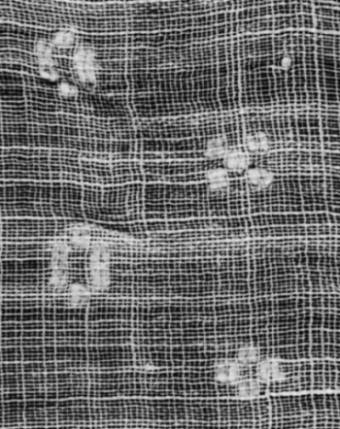
"Chrisam
gown", woven pattern, linen fabric,
probably eastern part of Switzerland, mid 18th c
Historic Museum of St.Gallen, Inv.No. 498

Detail of
"Chrisam gown",
| ANNE WANNER'S Textiles in History / cotton industry in Switzerland |
| Cotton fabrics in the
eastern part of Switzerland in the 18th century. Article dedicated to Krishna Riboud, in: CIETA-Bulletin No 80, 2003, page 68 - 74, by Anne Wanner-JeanRichard |
| page 3 of 5 back - next |
| Muslin Fabrics in India and Switzerland: |
| As early as 1790 Swiss
weavers started to use English machine-spun yarn for
their cotton fabrics. It was spun more evenly and
resulted in more beautiful and finer fabrics. As a
consequence the Swiss hand spinners could not earn their
living any more. They looked for a different kind of work
and they found an occupation in embroidery. There are only a very few fabrics preserved with a woven ornamentation. One of them was found in St.Gallen, Historic Museum and another one in Musée Galliera Paris: The so-called chrisam gown from the middle of 18th c. is preserved in the Historic Museum of St. Gallen. Chrisam is a balsamic oil and it was used in the church. For instance, fabrics were dipped into a liquid mixture of water and this oil. According to an old tradition, babies who cried a lot and did not put on weight had to wear this kind of garment in order to be cured. According to the Museums' inventary book the fabric is linen and the small motives were added in cotton thread. In eastern Switzerland such simple ornamented fabrics were called "gmügglet" which means decorated with small, mosquito-like motifs. This term can be found in San Gall chronicles since 1726. The part of a sleeve from the Musée Galliera in Paris has a very similar ornamentation. Also in this case the fabric could be linen, but so far it has not yet been analysed. If the fabric of these two examples is linen, its production in Europe in a place with a tradition of linen weaving like St.Gallen is possible. If this rather coarse groundfabric is cotton, then its manufacture in Switzerland could also be considered. |
Let us now look at the
technique of the ornamentation: the two examples
mentioned are made in a similar way to the Jamdani
weavings of Dacca, India. The muslins of Dacca
have long been famous and received poetic names to denote
their great beauty, such as: running water, woven air,
evening dew. The finest of all Dacca muslins was
"the king's muslin" which was made in a length
of approximately 10 yards by 1 yard and it contained from
1000 to 1800 threads in the warp. It could only be made
during the monsoon season when the moisture in the air
enabled the thread to be woven. The "Jamdani"
or figured muslins have been spoken of as the
chef-d'oeuvre of the Indian weaver. They employed a very
fine brocading technique practised only in Dacca and they
are still made there. Two men work together at the same
loom, one at each side. The pattern drawn on paper is
placed below the warp. With two pointed bamboo sticks the
men draw the threads between the warp as may be equal to
the width of the figure which is to be formed. As weaving
progresses they insert at regular intervals geometric
motifs or flowers in white or coloured cotton or silk and
also in gold or silver thread. It seems that the two examples in question are too simple in their ornamentation to be Indian, they look more like a copy of the very skilled Jamdani weaving. It is also possible that they were produced, before another technique, the whitework embroidery, became popular. |
"Chrisam
gown", woven pattern, linen fabric, |
Detail of
"Chrisam gown", |
Detail of tied
fitting upper garment (angrakha), which depicts tiny leaf
pattern all over the field. |
Corner of head
covering (oradhni or chadar), depicting board border of
zigzag pattern and squares on the field. |
| Introduction | Zellweger | Muslins | Tambour | Literature |
| content | Last revised July 29, 2004 |